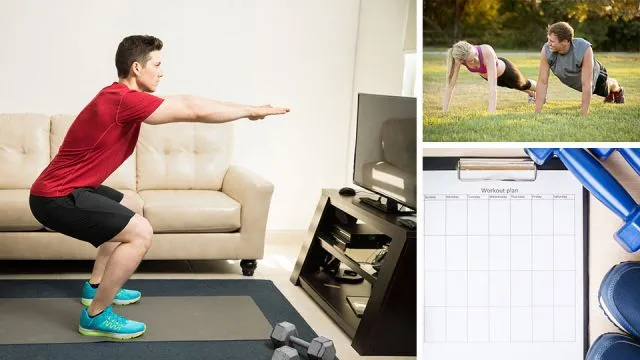
- Share on Facebook33
- Share on Pinterest
- Share on Twitter
So, you’ve decided it’s time to embark on a fitness journey. Perhaps you heard some pretty harsh facts from your doctor at a recent physical, or a trip to the mall dressing room resulted in a stranger staring back at you in the mirror. Maybe it’s become harder and harder to keep up with your kids or participate in the same activities you used to enjoy. Or, just maybe, it’s none of those things and instead you’ve come to the realization that exercising is key to staying happy and healthy.
Regardless of your reason, making the decision to put your health and wellness as a priority is one of the best things you can do for yourself and those around you. However, as noble as the goals may be and as eager and willing as we are in the beginning, the truth is that developing and sticking to a fitness plan can be nearly as difficult as the actual working out.
Thankfully, it takes just 21 days to form a habit — which means you are just three weeks away from making exercise just as much a part of your daily life as brushing your teeth and showering (two things that, I hope, you already do every day). Will it be easy? Probably not. Will it be worth it? You bet.
Here are some tips to remember for getting in tip-top shape.
1. Plan ahead and schedule your workouts
One of the greatest challenges when beginning a fitness routine is trying to make it fit into your daily life. In fact, a reason why so many people are unable to stick to an exercise routine is not because they are lazy, but rather it can be difficult finding the time in an already hectic schedule.
The solution? Treat your workouts like you would any other appointment. That means manually going into your calendar and writing it down like you would a doctor’s appointment or lunch meeting with colleagues. This will not only hold you accountable but also allow you to see where and when in the day is best for you to exercise.
Don’t get hung up on the fact that some days you’ve only got 30 minutes in the morning while other days you can devote an hour on your lunch break — it’s okay in the beginning to experiment with different times to see what you like best. As long as you are setting aside the time to do it, the rest will follow.
2. Set (smaller) realistic goals

Of all the things people tell me when they first start exercising, the absolute worst is usually something along the lines of “I’m going to hit the gym every day” or “I just need to lose 15 pounds a month and I’ll be good.” While there is absolutely nothing wrong with aiming high for your goals, the reality is, it’s setting you up for failure. No one goes from being a novice to an expert overnight — it takes time and practice.
Joining a gym and telling yourself that you’re going to workout every day is not only going to lead to severe burnout, but also the disappointment of not being able to keep your original goal and ending up becoming discouraged. When you become discouraged and feel as though you aren’t able to reach your goal, you may want to give up entirely. It’s a vicious cycle that does nothing but make us feel discouraged.
Here’s the solution: Set smaller goals that allow you to track your progress. They can be anything from being able to do 10 push-ups unassisted, run a mile without stopping or finally getting the courage to try that new fitness studio that opened in your neighborhood. Once you’ve achieved those feats, you’ll add more to the list and so on. It will not only boost your confidence to try new things but allow you to see your improvements.
3. Avoid “gymtimidation”
Much like being the new kid on the first day of school, there is a certain level of intimidation that comes with joining a gym or fitness studio. It is easy to look around at the super fit gym-goers and bodybuilders and feel a sense of inadequacy. They all seem as though they know what they’re doing and that they’re clearly going to notice if you’re there, unsure and out-of-shape.
However, it is important to remember two things. The first is that even the most elite of athletes was once a beginner that did not know their way around a weight rack. The second, and perhaps most important, thing to remember is that nobody is going to be paying nearly as much attention to you as you think they are. Look around your neighborhood gym or fitness studio. Do you see how there are mirrors seemingly everywhere? That means everyone is staring at themselves — they are too caught up in their own appearance to notice what you’re doing!
All joking aside, mirrors are important in gyms so that individuals can watch themselves to ensure proper form (and to flex in between sets) — they are not there to point out the new kid on the block. So try and take it easy on yourself.
Additionally, if you’re joining a gym for the first time, most fitness clubs offer a complimentary personal training session just for signing up. I cannot recommend this enough. Personal trainers are there to help you achieve your fitness goals, make you comfortable on the gym floor and give you insight and pointers on things you should (and should not) be doing. Take advantage of this free service and chances are you’ll walk away with some newfound confidence and a better understanding of the kind of workouts that are best for your body type.
4. Find a workout buddy

For an extra boost of confidence — and social interaction — think about recruiting a friend to begin working out with you. This can be especially helpful when navigating your way around a new gym or when taking up a new activity like running or walking. Having a friend will instantly add a level of comfortability to your new routine and allow you to take some of the focus off of yourself.
Plus, it increases your accountability because you now have someone who is counting on you to help them achieve their own fitness goals and has set the time aside to make it a priority. It is a lot harder to cancel on someone (and have to explain why) than just bailing on yourself.
If exercising with a friend is not an option, consider joining a fitness studio or local Meetup in your neighborhood such as a run club. The added benefit of social interaction will make exercising feel less like a chore and more like a fun outing with friends.
5. Remember to have fun
One of the biggest misconceptions about working out is that it has to be boring or painful in order for you to see any results. This could not be further from the truth. Exercise is one of the absolute best ways to reward your body — more so than getting a pedicure, a massage or anything one would consider “treating” themselves. The endorphin rush and sense of accomplishment alone can be addicting, not to mention the increased sex drive, confidence and numerous other benefits you’ll receive simply by adding some form of physical activity to your daily life.
So why don’t more people do it? I believe it is because they have not found the type of exercise that best suits them. Working out doesn’t just mean lifting dumbbells in a gym or running outside. There is a myriad of options to choose from. These days there are fitness studios that range in style from the more well-known pilates and yoga to classes that incorporate dance, rowing machines and, believe it or not, trampolines and jungle gyms. This means it’s possible to get your sweat on and relive your childhood.
Just because you haven’t found the right workout for you yet, doesn’t mean it’s not out there. Consult deal-based websites like Groupon for listings in your area or call local studios and inquire if new members get their first class free or discounted (most do offer this perk). Allow yourself the time to try out different styles of exercise until you find the one that you most enjoy.
— Megan Harris
- Share on Facebook33
- Share on Pinterest
- Share on Twitter

